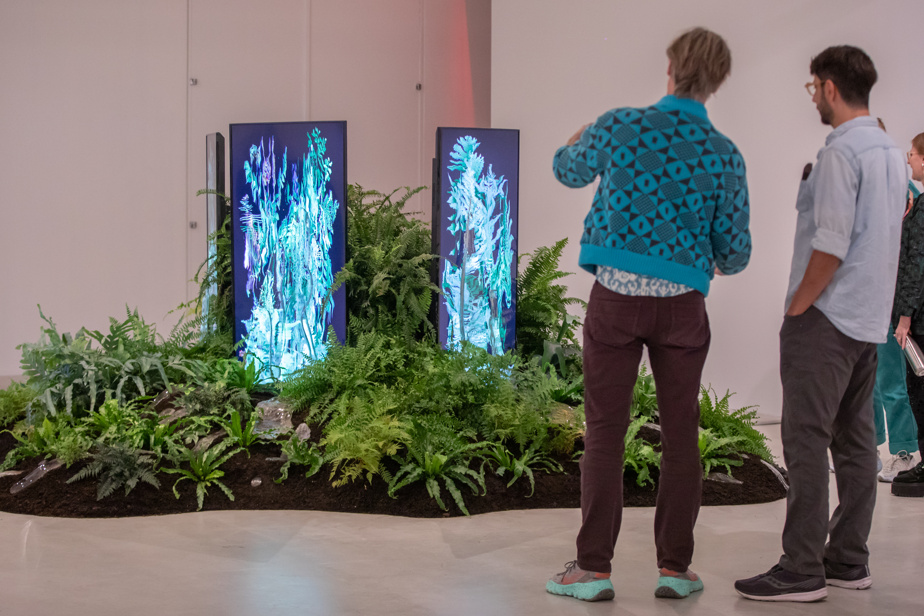Did you miss Julie Favreau’s exhibition, Les intuitions, inspired by the growing presence of artificial intelligence? Or even Biophilia, on the theme of the climate crisis? Nevermind ! It’s time to catch up with them by taking a quick detour through Joliette. That’s what we did.
Anxiety can be heavy to carry on a daily basis, but it can also be a source of extraordinary creativity and beauty if we rely on the works exhibited at the Joliette Art Museum in its two temporary exhibitions launched in the fall , which continue during the holiday season.
Take Biophilia, which of course evokes our love of nature and living things. Well, to preserve our environment in these troubled times, we must rethink our ways of doing things, change our habits, break in some way with this idea of domination of nature and exploitation of resources until their exhaustion, reminds us -your.
The artists invited to participate in this exhibition have each made their contribution to this building by inviting us to reconnect with nature.
The centerpiece of the exhibition is an installation by Katherine Melançon called Towards a Parliament of the Living. We see a display on the ground of (real) ferns in the ground, in the center of which three giant screens (in the shape of telephones) are planted. At the edge of this arrangement of ferns, from which pieces of glass emerge that resemble patches of ice, we can see a small pile of coal stones.
The compression of ferns in the soil over time is at the origin of the formation of coal, tells us the co-curator of the exhibition and interim curator of contemporary art, Marianne Cloutier. The installation therefore presents us with the past, with ferns and coal, which is at the origin of the industrial era.
The screens are animated thanks to the presence of sensors scattered throughout the city of Joliette, in places where there is industrial activity. These devices notably capture the activity of the wind and the sun and are at the origin of the animations that we can see. The coal comes from the Drummond mine, in Nova Scotia, infamous for the accident that forced its closure.
In this same exhibition, we can see around twenty works bearing the title Transactions, by Joshua Schwebel. This Ontario artist, who now lives in Berlin, used Dall-E software to create images using artificial intelligence – which were then painted by students from the Pierre Lassonde School of Fine Arts at the Nouveau -Brunswick. Read on, you will understand.
He asked the system to send back creations of gold mine landscapes in the style of… Riopelle, Jean Paul Lemieux, Fernand Leduc, Alfred Pellan, etc.
“In fact, Joshua Schwebel wanted to challenge Pierre Lassonde, who owns many of these works which represent landscapes, but who made his fortune in the mining sector, which paradoxically destroys landscapes,” explains Marianne Cloutier. It’s a snub to philanthropy in general, because we don’t always question the source of the funds that come to us from patrons…” Subversive, you say?
Last mention about Biophilia, a rather confusing projection by Chinese artist Zheng Bo, The Rite of Spring, presented at the Venice Biennale in 2022, which projects us into a Swedish pine forest where a group of completely naked men indulges in nature in a burst of eroticism. Whether rubbing against moss surfaces or clinging to trees in a sort of declaration of love. A phenomenon called ecosexuality. You have to see it to believe it.
Another subject of anxiety creatively channeled by the artist Julie Favreau, who also lives in Berlin: the growing role of artificial intelligence.
Inspired by the writings of Italian philosopher Federico Campagna (who was interested in interactions between humans and machines), the Quebec artist imagined a near future where this artificial intelligence would materialize. She chose to represent it by a suspended entity (blob) with which humans seek to come into contact to interact with it.
In a video filmed in a forest in Europe, Membrane, we can see people trying to communicate with this entity through their gestures (rather than through speech). And in an immersive virtual reality experience (with a VR headset), you find yourself projected into a forest in the presence of this entity, which you can follow and try to capture with your hands….
“Artificial intelligence exists and is becoming a new form of life,” explains co-curator Marianne Cloutier. What Julie Favreau imagined is our life with these entities and our possible interactions with them. She has a mysterious aesthetic, in her work with textures also which we can observe with her prints on canvas. »
A reflection on post-humanism, with the air of a cabinet of curiosities, which raises relevant questions.
